
Del Amo Fashion Center is a three-level regional shopping mall in Torrance, California, United States. It is currently managed and co-owned by Simon Property Group.

The Los Cerritos Center is a super regional shopping mall located in Cerritos, California. Since September 1971, the Los Cerritos Center has been an integral part of the city of Cerritos' tax revenue. The mall is the city's largest revenue source, producing $581 per square foot in sales in 2010. The tax revenue generated from the Los Cerritos Center for its host city totals to approximately $3 million a year. The facility is owned by Macerich & GIC Private Limited.
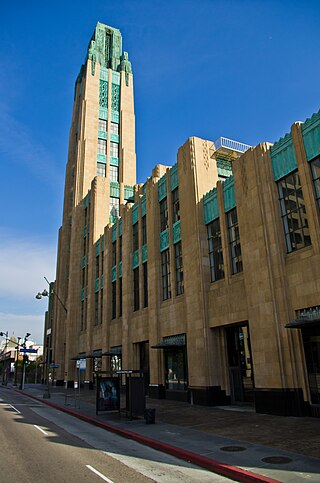
Bullocks Wilshire, located at 3050 Wilshire Boulevard in Los Angeles, California, is a 230,000-square-foot (21,000 m2) Art Deco building. The building opened in September 1929 as a luxury department store for owner John G. Bullock. Bullocks Wilshire was also the name of the department store chain of which the Los Angeles store was the flagship; it had seven stores total; Macy's incorporated them into and rebranded them as I. Magnin in 1989, before closing I. Magnin entirely in 1994. The building is currently owned by Southwestern Law School.
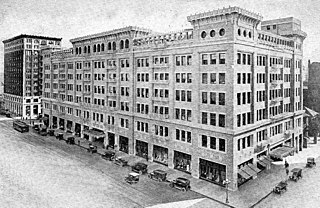
J. W. Robinson Co., Robinson's, was a chain of department stores operating in the Southern California and Arizona area, previously with headquarters in Los Angeles, California.

Bullock's was a chain of full-line department stores from 1907 through 1995, headquartered in Los Angeles, growing to operate across California, Arizona and Nevada. Bullock's also operated as many as seven more upscale Bullocks Wilshire specialty department stores across Southern California. Many former Bullock's locations continue to operate today as Macy's.
I. Magnin & Company was a San Francisco, California-based high fashion and specialty goods luxury department store. Over the course of its existence, it expanded across the West into Southern California and the adjoining states of Arizona, Oregon, and Washington. In the 1970s, under Federated Department Stores ownership, the chain entered the Chicago, and Washington, D.C., metropolitan areas. Mary Ann Magnin founded the company in 1876 and named the chain after her husband Isaac.
The Broadway was a mid-level department store chain headquartered in Los Angeles, California. Founded in 1896 by English-born Arthur Letts Sr., and named after what was once the city's main shopping street, the Broadway became a dominant retailer in Southern California and the Southwest. Its fortunes eventually declined, and Federated Department Stores bought the chain in 1995. In 1996, Broadway stores were either closed or converted into Macy's and Bloomingdales.

May Company California was an American chain of department stores operating in Southern California and Nevada, with headquarters at its flagship Downtown Los Angeles store until 1983 when it moved them to North Hollywood. It was a subsidiary of May Department Stores and merged with May's other Southern California subsidiary, J. W. Robinson's, in 1993 to form Robinsons-May.
Lakewood Center is a super-regional shopping mall in Lakewood, California. Lakewood Center opened in 1952 and was enclosed in 1978.
Steinbach was a department store chain based in Asbury Park, New Jersey with locations throughout the United States northeast. It opened in 1870 and was purchased by Supermarkets General Corporation (SGC) in the 1960s, and was shuttered in early 1999.
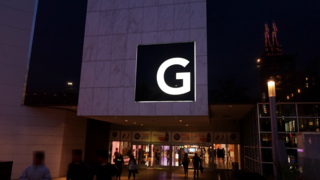
The Glendale Galleria is a large three-story regional shopping center and office complex located in downtown Glendale, California, United States. Opened in 1976 with 1,600,000-square-foot (150,000 m2) of retail space, it is the third-largest mall in Los Angeles County after Lakewood Center and Del Amo Fashion Center.
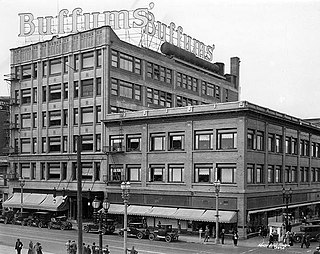
Buffums, originally written as Buffums' with an apostrophe, was a chain of upscale department stores, headquartered in Long Beach, California. The Buffums chain began in 1904, when two brothers from Illinois, Charles A. and Edwin E. Buffum, together with other partners, bought the Schilling Bros., the largest dry goods store in Long Beach, and renamed it The Mercantile Co. The store grew to a large downtown department store, and starting in the 1950s, grew slowly over the years to be a small regional chain of 16 speciality department stores across Southern California at the time of its closure in 1990.

Bond Clothing Stores, Bond Clothes, Bond Clothiers, or Bond Stores, was a men's clothing manufacturing company and retailer. The company catered to the middle-class consumer.

The Shops at Palm Desert is a shopping mall located in Palm Desert, California which serves the Coachella Valley. The mall features the traditional retailers Macy's, JCPenney, Dick's Sporting Goods, and Barnes & Noble, with 122 inline stores. In addition, the mall includes a food court and Tristone Palm Desert 10 Cinemas. The cinema has closed as of February 5, 2023. Numerous theater chains have been in discussion.

Desmond's was a Los Angeles–based department store, during its existence second only to Harris & Frank as the oldest Los Angeles retail chain, founded in 1862 as a hat shop by Daniel Desmond near the Los Angeles Plaza. The chain as a whole went out of business in 1981 but Desmond's, Inc. continued as a company that went in to other chains to liquidate them. Desmond's stores in Northridge and West Covina were liquidated only in 1986 and survived in Palm Springs into the first years of the 21st century.
La Mirada Mall was a 72-acre (29 ha) regional shopping mall at the southeast corner of La Mirada Boulevard and Rosecrans Avenue in La Mirada, California, in southeast Los Angeles County, in a region known as the Gateway Cities. It is now the site of the La Mirada Theater Center, a strip mall.
Marina Pacifica is a marina-adjacent shopping mall featuring movie theaters, shopping, dining & copious parking. It is in southeastern Long Beach, California between Second Street and the Los Cerritos Channel. The shopping center has variously been named Marina Pacifica Mall and Marina Pacifica Shopping Center.

7th Street is a street in Los Angeles, California running from S. Norton Ave in Mid-Wilshire through Downtown Los Angeles. It goes all the way to the eastern city limits at Indiana Ave., and the border between Boyle Heights, Los Angeles and East Los Angeles.
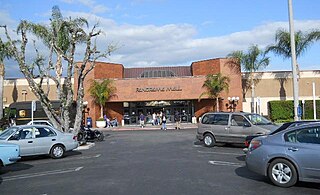
Panorama Mall is a mall in Panorama City, San Fernando Valley, Los Angeles, California. It is an enclosed mall anchored by two large discount stores, Walmart and Curacao, aimed primarily at a Hispanic customer base.

Retail in Southern California dates back to its first dry goods store that Jonathan Temple opened in 1827 on Calle Principal, when Los Angeles was still a Mexican village. After the American conquest, as the pueblo grew into a small town surpassing 4,000 population in 1860, dry goods stores continued to open, including the forerunners of what would be local chains. Larger retailers moved progressively further south to the 1880s-1890s Central Business District, which was later razed to become the Civic Center. Starting in the mid-1890s, major stores moved ever southward, first onto Broadway around 3rd, then starting in 1905 to Broadway between 4th and 9th, then starting in 1915 westward onto West Seventh Street up to Figueroa. For half a century Broadway and Seventh streets together formed one of America's largest and busiest downtown shopping districts.












